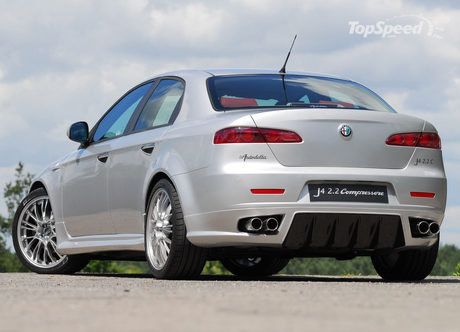 alfa romeo 159
alfa romeo 159 alfa romeo 159 by autodelta
alfa romeo 159 by autodelta alfa romeo 159 interior1
alfa romeo 159 interior1
 Replacing the much-loved and stylistically bold 156 was never going to be an easy task, but Alfa Romeo has been around long enough to know what works and what doesn't.
Replacing the much-loved and stylistically bold 156 was never going to be an easy task, but Alfa Romeo has been around long enough to know what works and what doesn't.And according to the Italian automaker, the new 159 most definitely works, but not without a little bit of Aussie know-how, which we'll touch on later.
Like the just-released Brera, the 156's replacement shows off Alfa Romeo's new face, which is a little less swoopy than before, slightly more pinched in, yet with more out-and-out style and a slightly sportier edge.
The 156 was a pivotal model for Alfa when it launched, bringing with it sales records for a company that was once looking very poorly. Therefore the 159 needed to be drop-dead gorgeous, and in my humble opinion it has achieved this.
The triple cluster headlights work remarkably well, lending the Italian mid-sized sedan more purpose, and if you look at the car as a whole, it's a much more elegant, stylish proposition than the 156, with fewer seams between a reduced number of sheet metal panels. All told, it's got a very 'taught' look.
Alfa Romeo's new look 159 is the end result of a collaboration between Italian design maestro Giorgetto Giugiaro and the car maker's own Styling Centre, and "the rear end, with its beautifully balanced form, blends perfectly with the front, setting off its unique personality," according to Alfa Romeo.
Though the 159 will be replacing the 156, the new Italian sedan is in fact a much larger car than its precursor, with increases in almost every dimension, and from any angle and at almost any distance, the 159 is unmistakably an Alfa Romeo.
It's an Italian car that exudes style and sophistication, but underneath its freshly stamped sheet metal lies an Australian-made beating heart.
The range-topping Alfa Romeo 159 will be powered by a General Motors 3.2-litre V6, which will be built in Australia, and Alfa claims that it's new range of engines will be respectful towards the environment, while at the same time giving drivers good reserves of power.
Sitting atop the 159 range will be the 3.2-litre V6, which will output a Commodore-like 191kW (260hp) and generate some 322Nm of torque @ 4500rpm. Both figures are quite impressive, particularly for a naturally aspirated 3.2-litre engine.
In contrast, Holden's 3.6-litre Alloytec190 motor cranks out 340Nm of torque, just 18Nm more than the Alfa's smaller 3.2-litre engine, but it should be stressed that the Alfa donk is a more advanced (and expensive) piece of kit, taking advantage of direct petrol injection, or JTS (Jet Thrust Stoichiometric) in Alfa-speak.
Two other petrol engines will be offered by Alfa Romeo, but it's not yet clear which ones will be imported when the 159 finds its way to Australian showroom floors in 2006.
The 2.2-litre and 1.9-litre inline 4-cylinder engines output 136 and 118 kilowatts of power respectively - very solid figures again - and together with the 3.2-litre mill they all use continuous 'dual' variable valve timing, where both intake and exhaust valves get the full variable billing. Peak torque for the 2.2 and 1.9 motors is 230Nm and 190Nm.
Only one example of the many diesel engines is likely to make its way to Australia after Europe has taken its fill of the 159, and here's hoping it's the range-topping 2.4-litre JTDM 5-cylinder mill.
It squeezes out a very respectable 147kW (200hp) and a whopping 400Nm of torque @ 2000rpm. A diesel-powered sports that performs well and is as visually attractive as the 159 would do wonders for diesel's name in Australia.
Other diesel engines common to the 159 include two 1.9-litre turbo diesels, the major difference between the two being valve count.
The more powerful 16-valve oil burner delivers 110kW (150hp) @ 4000rpm and 320Nm @ 2000rpm, while the 8-valve 1.9-litre engine makes 88kW (120hp) and 280Nm of torque.



